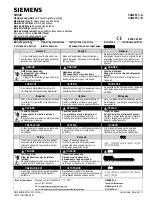
Manual MRR1 GB
Woodward
DOK-TD-MRR1 Rev.A
19
6.4.5 Checking the pickup value and reset value
For testing these values a current smaller than the adjusted pickup value has to be injected (ter-
minals B1 - B2). The current is now to be increased until the relay picks up, which is indicated by
lighting up of LEDs le and le>. At the same time the output relay selected by the parameter setting
mode (see chapter 5.3.2) trips. The value shown at the ammeter must not vary more than
2 % from the adjusted pickup value of the MRR1. The resetting value is ascertained by slowly de-
creasing the test current until the output relay re-leases. Check that the resetting current is 0.98
times smaller than the operating current. This method is also to be used for the insulation
measuring circuit.
6.4.6 Checking the tripping delay
For checking the tripping delay a timer is to be connected to the trip output relay contact. The timer
should be started simultaneously with the test current injection in the current input circuit and
stopped at the instant the relay trips. The test cur-rent should be 1.5 times the operating current.
The tripping delay measured by the timer should not vary more than 3 % or less than 150ms from
the adjusted tripping delay.
For checking the insulation measuring circuit the same method can be used. The permissible
tolerance for this is 3 % or less than 1s from the adjusted tripping delay.
6.5 Real injection test
Generally, a test with real exciter current could be carried out in the similar manner as the injection
test with current sources above described. Since the cost and potential hazards are very high for
such a test, especially if staged fault tests are in-tended, these tests are usually limited to very
important protective relays in the power system.
Because of its powerful combined indicating and measuring functions, you have still the possibili-
ties to test the MRR1 relay in the manner of a primary injection without extra expenditures and time
consumption.
In actual service, for example, the measured cur-rent values may be compared with the ammeter
on the switch-board panel to verify that the relay works and measures correctly.
6.6 Maintenance
Maintenance testing is generally done on site at regular intervals. These intervals vary among us-
ers depending on many factors: e.g. the type of protective relays employed; the importance of the
primary equipment being protected; the user's past experience with the relay, etc.
For electromechanical or static relays, maintenance testing will be performed at least once a year
according to the experiences. For digital re-lays like MRR1, this interval can be substantially longer.
This is because:
The MR-relays are equipped with very wide self-supervision functions, so that many faults
in the relay can be detected and signalized during ser-vice. Important: The self-supervision
output relay must be connected to a central alarm panel!
The combined measuring functions of MR-relays enable supervision the relay functions
during
service.
The combined TRIP test function of the MR-relay allows to test the relay output circuits.
A testing interval of two years for maintenance will, therefore, be recommended.
During a maintenance test, the relay functions including the operating values and relay tripping
times should be tested.



































